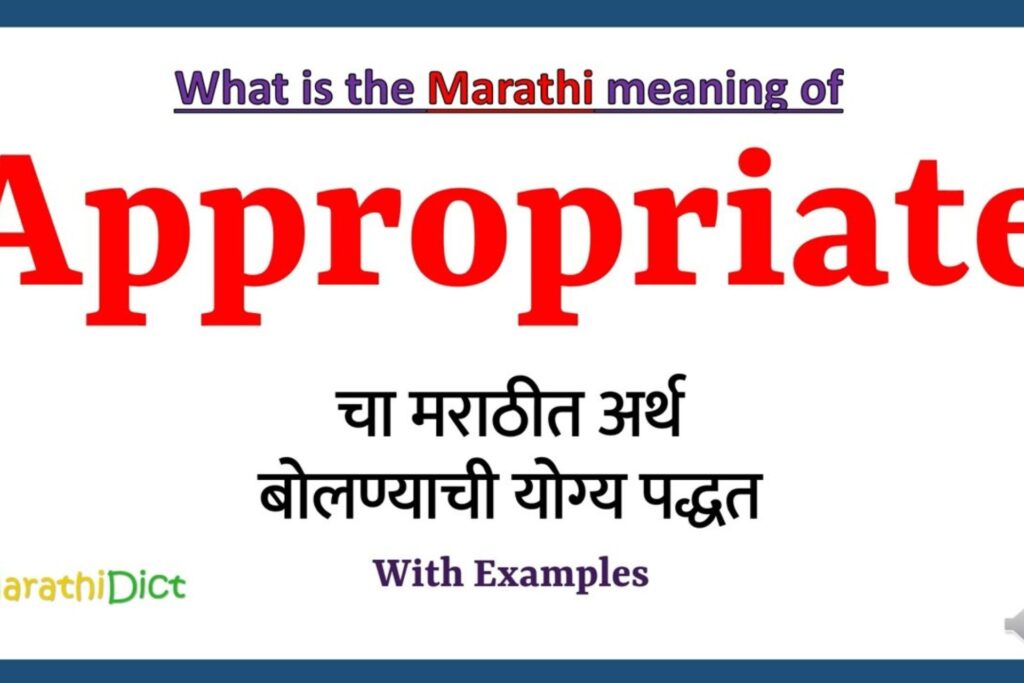Introduction: In a world where communication transcends borders, understanding the subtleties of language is crucial. Translating words accurately from one language to another ensures clear and effective communication. Marathi, one of India’s prominent languages, offers a rich linguistic landscape. This article delves into the appropriate meaning of “appropriate” in Marathi, exploring its nuances and contextual usage.
The Significance of Translation
Accurate translation is more than just substituting words from one language to another. It involves understanding cultural contexts, idiomatic expressions, and the inherent meaning behind phrases. Misinterpretation can lead to confusion and miscommunication, highlighting the importance of precise translation.
Understanding “Appropriate” in English
The word “appropriate” in English is often used to denote suitability or correctness in a given context. It can describe behavior, attire, responses, and more. For instance, “appropriate attire” means clothing that is suitable for a particular occasion. Understanding its usage in different contexts helps in finding an accurate Marathi equivalent.
The Concept of “Appropriate” in Marathi
Translating “appropriate” to Marathi isn’t a straightforward task due to the linguistic and cultural differences. In Marathi, “appropriate” can be translated as “योग्य” (yogya), which carries a similar meaning of suitability or correctness. However, just like in English, the context in which it is used can alter its exact translation.
Linguistic Differences
English and Marathi are structurally different languages. English follows a subject-verb-object order, while Marathi often follows a subject-object-verb order. These structural differences can impact how translations are constructed, making direct translations challenging and sometimes leading to ambiguity.
Cultural Influences on Language
Language is deeply influenced by culture. Marathi, spoken predominantly in the Indian state of Maharashtra, reflects the region’s cultural and social norms. This cultural backdrop influences how certain words and phrases are used and understood. For instance, what is considered “appropriate” attire or behavior in one culture might differ significantly in another.
Common Marathi Words for “Appropriate”
Several Marathi words can convey the meaning of “appropriate,” depending on the context:
योग्य (yogya) – Suitable, correct
समर्पक (samarpak) – Apt, fitting
उचित (uchit) – Proper, apt
युक्त (yukta) – Suitable, proper
Each of these words is used in specific contexts, which we will explore further.
Case Studies: Translation in Practice
Let’s examine some examples to see how “appropriate” is translated into Marathi in various contexts:
These translations illustrate the adaptability of Marathi words to convey suitability in different scenarios.
Practical Tips for Translation
Accurate translation requires more than just a dictionary. Here are some tips:
Understand the Context: Always consider the context in which the word is used.
Cultural Sensitivity: Be aware of cultural nuances that may affect meaning.
Use Reliable Resources: Utilize dictionaries, language apps, and native speakers for assistance.
The Role of Context in Translation
Context is king in translation. A word can have multiple meanings based on how it’s used. For instance, “appropriate” in a legal document might differ from its use in everyday conversation. Always ensure the context aligns with the translation for clarity and accuracy.
Common Mistakes in Translation
Some frequent errors in translating “appropriate” to Marathi include:
Ignoring Context: Translating without considering the specific scenario can lead to incorrect meanings.
Literal Translation: Word-for-word translation often fails to capture the true essence.
Cultural Misunderstandings: Misinterpreting cultural references can result in inappropriate translations.
Learning Marathi for Better Translation
Learning Marathi can significantly enhance translation accuracy. Benefits include:
Deeper Understanding: Grasp the subtleties and idioms of the language.
Improved Accuracy: Reduce errors by knowing the language firsthand.
Enhanced Communication: Engage more effectively with Marathi speakers.
Advanced Translation Techniques
For nuanced translations, consider these techniques:
Dynamic Equivalence: Focus on conveying the same meaning rather than a literal translation.
Back-Translation: Translate back to the original language to check for accuracy.
Consult Native Speakers: They can provide insights into idiomatic expressions and cultural nuances.
Future of Translation Technology
AI and machine learning are revolutionizing translation. Tools like Google Translate are becoming more sophisticated, offering better contextual translations. However, human oversight remains crucial to ensure cultural and contextual appropriateness.
FAQs
What is the Marathi word for “appropriate”?
The Marathi word for “appropriate” is “योग्य” (yogya), among other context-dependent synonyms.
How does culture influence translation?
Culture shapes language use, idiomatic expressions, and contextual meanings, which are crucial for accurate translation.
Are there tools for better translation between English and Marathi?
Yes, tools like Google Translate, language dictionaries, and language learning apps can assist in translation, but human oversight is essential.
Why is context important in translation?
Context ensures that the translation conveys the intended meaning accurately, avoiding misinterpretation and ambiguity.
How can I improve my Marathi language skills?
Learning resources like language courses, apps, and engaging with native speakers can enhance your proficiency in Marathi.
Conclusion
Accurate translation between English and Marathi involves understanding linguistic structures, cultural contexts, and the specific use cases of words. By appreciating these nuances, we can ensure effective and meaningful communication.

